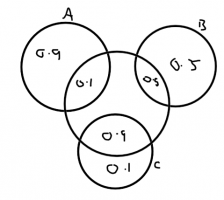How would I represent the following situation in a Venn diagram?
At a first interview for a job, candidates are divided into three groups, A, B or C. The probability of being put in group A is 0.5, group B is 0.3 and group C is 0.2. If a candidate is in group A, s/he has a probability of 0.1 of getting a second interview. Candidates in group B have a probability of 0.5 of getting a second interview and candidates in group C have a probability of 0.9 of getting a second interview.
At a first interview for a job, candidates are divided into three groups, A, B or C. The probability of being put in group A is 0.5, group B is 0.3 and group C is 0.2. If a candidate is in group A, s/he has a probability of 0.1 of getting a second interview. Candidates in group B have a probability of 0.5 of getting a second interview and candidates in group C have a probability of 0.9 of getting a second interview.

